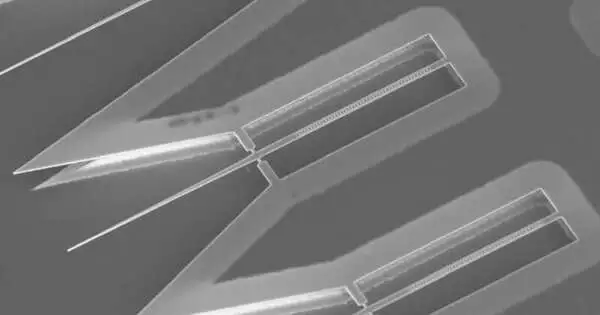Erbium atoms embedded in crystalline silicon have been excited by researchers at MPQ in Garching and the TU Munich to the point where they emit single photons. Their unique properties may serve as the foundation for the creation of extensive networks connecting quantum systems to one another and eventually leading to a quantum internet.
Through fiber-optic networks that can be demonstrated to be secure and private, this would make it possible to exchange information. The researchers’ innovative method offers significant advantages in the production of network nodes, cooling of those nodes, and data transmission range.
New technical applications, like the creation of highly sensitive quantum sensors and fast quantum computers, are made possible by the controlled use of quantum physical phenomena like the entanglement of several particles. Certain tasks that conventional computers could not solve can now be completed quickly with them.
“However, in order to make technical use of these fundamental properties of erbium, the atoms must be stimulated in a controlled manner to emit individual light particles. This allows for the creation of an interface for sending and receiving quantum information.”
Andreas Gritsch, a doctoral researcher in Andreas Reiserer’s team at the MPQ.
In the future, quantum networks could utilize these and other quantum technologies very effectively. A group of researchers from the Technical University of Munich (TUM) in Garching and the Max Planck Institute of Quantum Optics (MPQ) have now demonstrated a promising platform for their realization. The study has been published in Optica.
Prof. Dr. Andreas Reiserer, team leader, explains, “All quantum technologies are based on so-called qubits, the elementary carriers of quantum information.” A quantum network, similar to the “classical” internet of today, can be established by connecting them with light. Individual atoms that are separated from one another and embedded in a solid host material could serve as qubits.
Reiserer and his team recently demonstrated that erbium atoms in a silicon crystal work particularly well with this. The researchers then made an additional significant advancement: They excited individual erbium atoms in such a way that they released individual photons, which have properties that make them ideal for making quantum networks.
Ideal conditions for telecommunications were implanted by Reiserer’s research team for this purpose: doped: the atoms of the rare earth metal were inserted into specific positions in the silicon crystal lattice. The physicist explains that this gives the erbium atoms excellent optical properties: The wavelength of their light is 1,536 nanometers. Due to its relatively low loss, this is comparable to the light wavelength utilized for data transmission in fiber optic networks for conventional telecommunications. This enables the long-distance transmission of quantum information,” adds Reiserer.
According to Andreas Gritsch, a doctoral researcher in Andreas Reiserer’s group at the MPQ, “one has to stimulate the atoms to emit individual light particles in a controlled manner in order to make technical use of these fundamental properties of erbium.” Along these lines, a point of interaction for sending or getting quantum data can be made.”
Presently, the analysts in Garching and Munich have prevailed with regards to doing exactly that. They utilized an optical resonator—aa gadget that can mirror light and consequently intensify it—ffor this reason. ” “We have made a resonator from silicon doped with erbium for the first time,” states Gritsch.

Nanophotonic resonator on a silicium chip. Credit: MPQ
However, unlike most optical resonators, this one did not have mirrors; rather, it had a specific structure made of crystalline silicon: holes in the material that are regularly arranged and only a few nanometers (millionths of a millimeter) in size. There were only a few dozen erbium atoms in the entire unit, which measured just a few micrometers. The so-called nanophotonic resonator was connected to an optical fiber by the researchers, allowing laser light to enter and excite the atoms. Andreas Gritsch explains, “We were able to achieve the emission of individual photons with the desired characteristics in this manner.”
As a result, the physicist and his team have opened up the possibility of creating qubits specifically for the transport of quantum information. “Because this material has been used for decades to produce classic semiconductor elements, such as microchips for computers, smartphones, or navigation devices,” says Reiserer, “the fact that this is possible in crystalline silicon offers an additional opportunity for the realization of quantum networks.”
In the semiconductor industry, the necessary manufacturing procedures and techniques are technically mature and established. “This means that silicon crystals can also be produced in high quality and purity for applications in quantum technology, such as the construction of quantum networks,” Reiserer emphasizes, “and quite cheaply.”
The system developed by MPQ and TUM scientists also has one more benefit: Thanks to a unique method of preparation, the erbium atoms embedded in silicon exhibit excellent optical properties not only at temperatures as low as minus 273°C but also at temperatures as high as eight degrees above this point. And in practice, these few degrees make a big difference,” Reiserer explains. Because cooling in a cryostat filled with liquid helium at such temperatures is a technologically simple process,” This facilitates the development of technical applications.
Financial institutions, medical facilities, and government agencies that handle classified or sensitive personal data may be particularly interested in these. A quantum network would provide perfect data protection, whereas the best encryption currently available cannot. The quantum properties of prepared photons would be lost, rendering the data useless if an eavesdropper attempted to intercept it.
More information: Andreas Gritsch et al, Purcell enhancement of single-photon emitters in silicon, Optica (2023). DOI: 10.1364/OPTICA.486167





